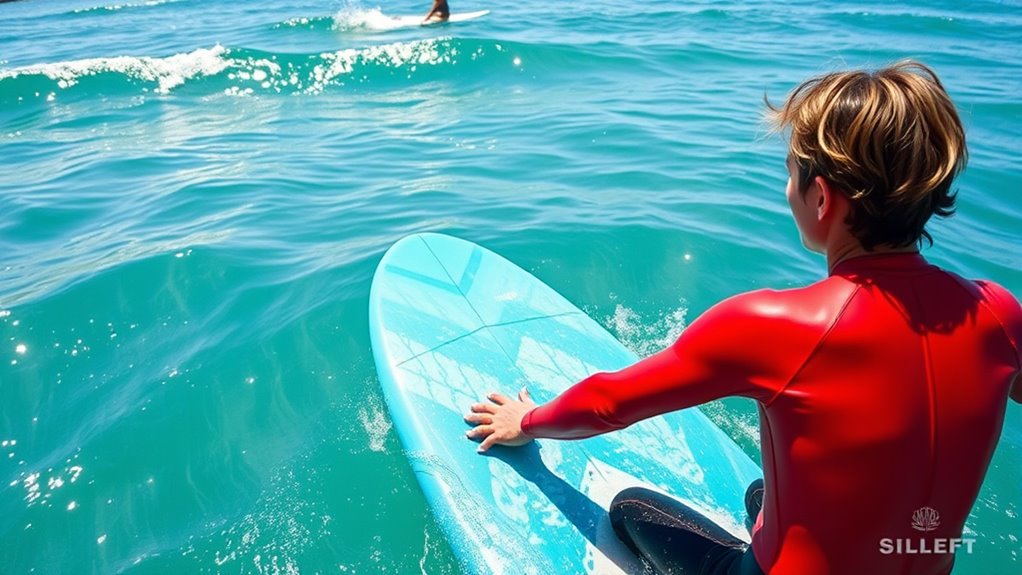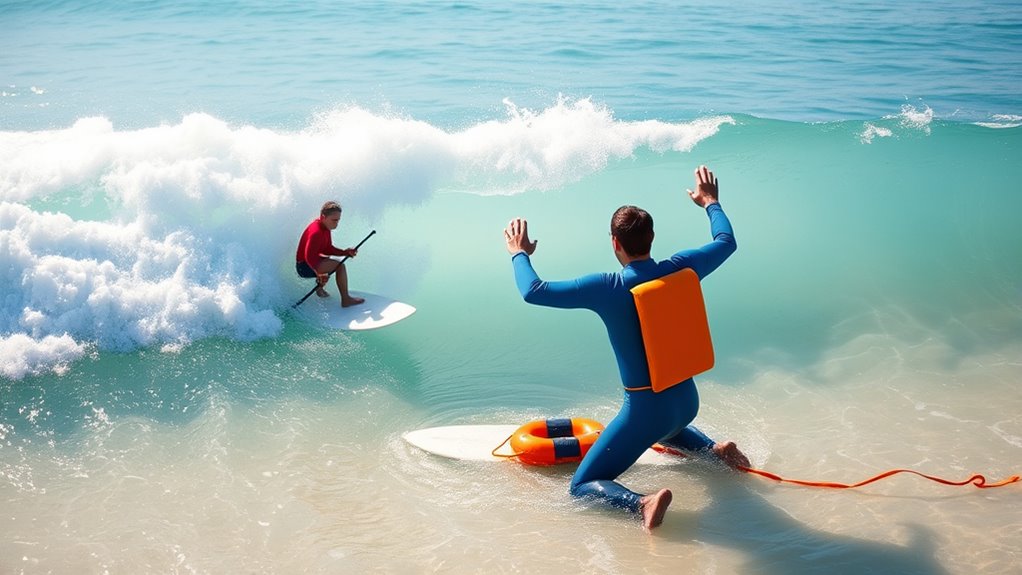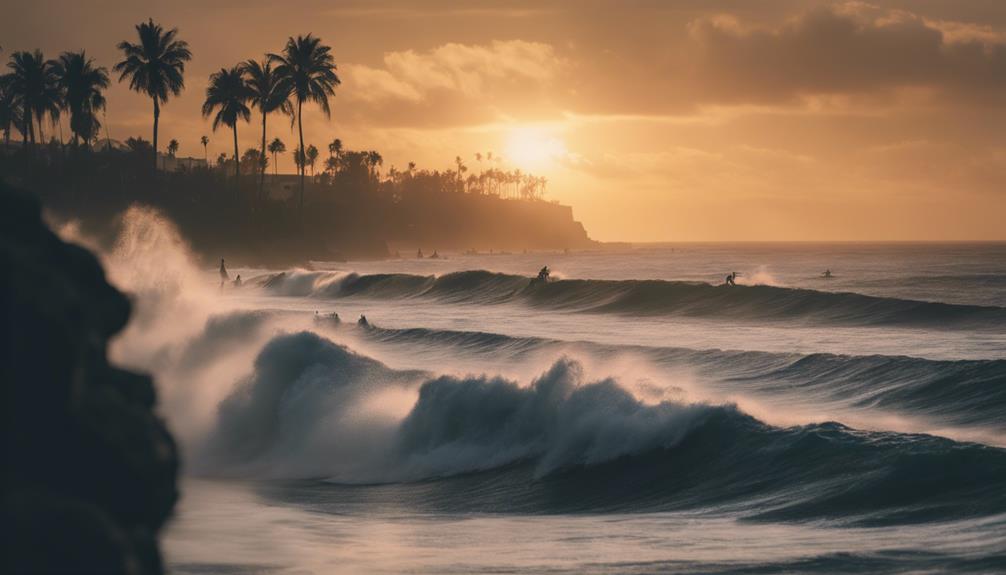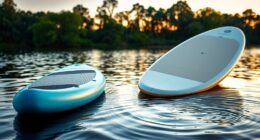When starting out, choose a surfboard suited for your skill level and make certain your wetsuit fits snugly. Always warm up before hitting the water with light stretching to prevent injuries. Watch the surf conditions, including wave size, currents, and tide, to find safe entry points. Respect surf etiquette and stay alert for hazards like rocks or marine life. Knowing how to react in emergencies ensures safety—keep exploring for more tips to surf confidently and safely.
Key Takeaways
- Select beginner-friendly surfboards and ensure proper wetsuit fit to enhance safety and comfort.
- Check wave size, tide, and current conditions to match your skill level and avoid hazards.
- Follow surf etiquette by waiting your turn and avoiding dropping in on others to prevent collisions.
- Recognize rip currents and turbulent water to safely navigate or avoid dangerous areas.
- Stay alert to changing conditions and use safety gear, including rescue techniques, for emergency preparedness.
Choose the Right Equipment

Have you ever wondered how the right equipment can make or break your surfing experience? It all starts with surfboard selection. Picking the right board depends on your skill level, body type, and the waves you’ll surf. Beginners should opt for a larger, more stable board to improve balance and control. As you progress, you might prefer a smaller, more agile board. Equally important is wetsuit fit. A wetsuit that fits snugly without restricting movement keeps you warm and comfortable, reducing fatigue and enhancing your confidence. Ill-fitting wetsuits can cause chafing or leave cold water in, making you uncomfortable and risking hypothermia. Taking the time to choose quality equipment tailored to your needs guarantees a safer, more enjoyable surfing experience from the start. Additionally, understanding self watering plant pots can help you maintain your garden more effectively, ensuring your plants stay healthy and hydrated with minimal effort. Proper skin exfoliation with glycolic acid can also improve your skin’s texture and resilience, making you feel more comfortable and confident while in the water. Incorporating the use of best oils for deep frying can also inspire healthier snack options post-surf. Moreover, selecting equipment with safety features such as leash attachments and traction pads enhances your overall safety while surfing. Using eye patches for post-surf recovery can also help reduce puffiness and refresh tired eyes after long sessions in the sun.
Understand Surf Conditions

Before hitting the water, you should check the wave size to make sure it’s suitable for your skill level. Pay attention to water currents, as they can pull you off course or make paddling more difficult. Understanding these conditions helps you stay safe and enjoy your time surfing. Additionally, being aware of potential hazards such as rocks or marine life can prevent accidents and ensure a safer experience. Monitoring water conditions like tide changes and wind direction can further improve your safety and surfing experience. Incorporating textile line awareness, such as the quality of surfboard wraps or protective gear, can also enhance your safety on the water. Recognizing essential oils for respiratory health, like eucalyptus or peppermint oil, can be useful in case you need to clear nasal congestion after exposure to cold or dry air during your surf session. Staying informed about the local gelato spots can also add a delightful treat to your day after surfing.
Check Wave Size
How do you know if the waves are safe to surf? Start by checking the wave height in the surf zone. Smaller waves, around 1 to 3 feet, are ideal for beginners, offering manageable conditions. Larger waves can be challenging and may pose risks, especially if you’re just starting out. Observe how the waves break—smooth, consistent breaks are safer than choppy, unpredictable ones. Pay attention to the surf zone to see if the waves are forming steadily and not crashing unpredictably. If the waves look too big or irregular, it’s best to wait for calmer conditions. Always assess the wave size relative to your skill level to ensure your safety and enjoyment in the water.
Observe Water Currents
Water currents profoundly impact surf conditions and your safety in the water. Understanding water flow and tide patterns helps you stay alert and avoid dangerous situations. Always observe how the water moves before entering the surf zone. Here are key points to keep in mind:
- Feel the water flow to identify rip currents that can pull you out.
- Watch tide patterns; low or outgoing tides often create stronger currents.
- Check for changing water movement, signaling shifting conditions.
- Recognize areas where water appears calmer or more turbulent.
- Familiarity with Grocery Savings Strategies can help you allocate more resources to safety gear and lessons, which is especially important for newcomers learning about water safety.
Warm Up and Stretch Before Surfing

Warming up and stretching your muscles is essential to prepare your body for the physical demands of surfing. Engaging in pre surf stretching helps loosen tight muscles and increase flexibility, reducing the risk of injury. Start with warm-up exercises like light jogging or arm circles to get your blood flowing. Focus on dynamic stretches that target your shoulders, back, legs, and hips, as these areas are heavily used while paddling and riding waves. Proper warm-up routines enhance your range of motion and mental focus, making your surf session safer and more enjoyable. Incorporating proper warm-up routines can also improve your overall performance and confidence in the water. Additionally, paying attention to celebrity lifestyle insights can motivate you to maintain consistent fitness routines that benefit your surfing. To further prevent injuries, consider monitoring your body’s readiness with technology like heart rate trackers during warm-up. Remember that understanding headphone compatibility with your devices can help you enjoy music safely while preparing for your surf session.
Practice Proper Surfing Techniques

Practicing proper surfing techniques is essential to staying safe and maximizing your enjoyment on the waves. Developing good surfing etiquette shows respect for others and keeps everyone safe. Focus on mastering paddling techniques to conserve energy and improve your control. Here are four key tips:
- Respect the lineup — wait your turn and avoid dropping in on others.
- Use smooth paddling techniques — stay relaxed, keep your strokes efficient, and avoid unnecessary splashing.
- Practice proper positioning — sit or lie on your board correctly to signal your intentions clearly.
- Communicate clearly — make eye contact and use hand signals to avoid surprises. Understanding group dynamics can enhance your ability to navigate crowded surf spots effectively. Being aware of narcissistic behaviors can help you better recognize and respond to potential conflicts or manipulative tactics in group settings. Incorporating water safety protocols into your routine ensures you are prepared for unexpected situations. Additionally, being familiar with group behavior can help you better anticipate and respond to the actions of others in the water. Recognizing the importance of emotional alignment can also improve your confidence and overall experience while surfing. Following these techniques helps you stay safe, reduces accidents, and ensures a positive surf experience for everyone involved.
Be Aware of Your Environment and Other Surfers

Being aware of your environment and other surfers is key to staying safe and enjoying your time in the water. Respect the local surf etiquette, which helps prevent conflicts and keeps everyone safe. Pay attention to how surfers position themselves and take turns, so you don’t accidentally cut someone off or cause a collision. Always be alert for identifying hazards like rocks, reefs, or strong currents that could surprise you. Watching for warning signs and understanding the surf conditions helps you avoid dangerous areas. Keeping an eye on your surroundings, so you can react quickly if someone needs help or if a situation changes. Staying mindful of your environment and fellow surfers creates a safer, more enjoyable experience for everyone. Being aware of current surf conditions can also help you plan your session and avoid unexpected dangers. Additionally, understanding industry transformations, such as the integration of AI automation in safety equipment, can provide new tools to enhance your safety measures.
Know How to Handle Emergencies

Knowing how to handle emergencies is essential for staying safe in the water. If trouble strikes, staying calm and knowing rescue techniques can make all the difference. Here’s what you should do:
Handling emergencies calmly and knowing rescue techniques are vital for water safety.
- Use emergency signaling—wave your arms or shout to attract help.
- Stay calm—panicking wastes energy and clouds judgment.
- Perform rescue techniques—if someone’s in trouble, support their head and guide them to safety.
- Keep an eye out—look for lifeguards or fellow surfers who can assist.
Mastering these skills ensures you’re prepared for unexpected situations. Recognizing when to signal for help and how to assist others can save lives. Always stay alert, and remember, quick action can turn a dangerous moment into a safe one.
Frequently Asked Questions
How Can I Identify Safe Surf Spots for Beginners?
To identify safe surf spots for beginners, start by researching beaches with good beach amenities like lifeguards, gentle waves, and clear entry points. Talk to local surfers to understand the surf culture and which spots are beginner-friendly. Look for beaches with calm waters, shallow depths, and consistent wave patterns. These cues help make certain you find a safe environment to learn and enjoy surfing, building confidence step by step.
What Should I Do if I Get Caught in a Rip Current?
When caught in a rip current, stay calm and conserve your strength. Recognize rip current safety by resisting the urge to swim against it; instead, swim parallel to the shoreline until you’re out of the rip. Remember rescue techniques like signaling for help if needed. Keep your cool, float, and focus on freeing yourself from the current’s grip. Patience and awareness are your best tools in these tricky situations.
Are There Specific Signs Indicating Dangerous Surf Conditions?
You should watch for surf warning signs that indicate dangerous surf conditions. Look for murky water, large breaking waves, or a lot of foam, which can signal dangerous surf. Pay attention to flags or posted warnings at the beach. If you see these signs, it’s best to stay out of the water. Dangerous surf can quickly become hazardous, so always heed surf warning signs to keep yourself safe.
How Do I Choose the Best Wetsuit for Different Water Temperatures?
Did you know that selecting the right wetsuit can increase your water comfort by up to 50%? When choosing a wetsuit for different water temperatures, focus on wetsuit material and thermal insulation. Neoprene is common for its flexibility and warmth. For colder waters, opt for thicker suits, while thinner suits work well in milder temperatures. Proper fit is essential to maximize thermal insulation and stay comfortable during your surf sessions.
What Are Some Common Mistakes to Avoid as a Beginner Surfer?
As a beginner surfer, you should avoid common mistakes like neglecting proper paddle technique and overlooking surfboard maintenance. Using improper paddle technique can tire you out and make paddling inefficient, while ignoring surfboard upkeep can lead to damage or safety issues. Focus on refining your paddling and regularly check your board for dings. These habits help you stay safe, improve your skills, and enjoy surfing more confidently.
Conclusion
By following these safety tips, you’ll ride the waves with confidence and care. Think of surfing as a dance with the ocean—respect it, and it’ll be your partner in adventure. Always choose the right gear, stay aware of your surroundings, and know how to handle emergencies. With preparation and caution, you’ll turn those crashing waves into a thrilling, safe experience—your own epic story written in saltwater and sunshine.










